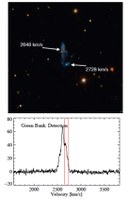Low-mass Galaxy Evolution
 TiNy Titans (TNT) is the first systematic study of star formation and the subsequent processing of the interstellar medium in interacting dwarf galaxies. This paper presents the first results from a multi-wavelength observational program based on a sample of 104 dwarf galaxy pairs selected from a range of environments within the spectroscopic portion of the Sloan Digital Sky Survey and caught in various stages of interaction. The dwarf–dwarf merger sequence, as defined by TNT at z = 0, demonstrates conclusively that the star formation enhancement observed for massive galaxy pairs also extends to the dwarf mass range. Star formation is enhanced in paired dwarfs in otherwise isolated environments by 2.3x at pair separations <50 kpc relative to unpaired analogs. The enhancement decreases with increasing pair separation and extends out to pair separations as large as 100 kpc. Starbursts occur in 20% of the TNT dwarf pairs, regardless of environment, compared to just 6-8% of the matched unpaired dwarfs. Starbursts can be triggered throughout the merger and not just approaching coalescence. Despite their enhanced star formation and triggered starbursts, most TNT dwarf pairs have similar gas fractions relative to unpaired dwarfs of the same stellar mass. There may be significant reservoirs of diffuse, non-star-forming neutral gas surrounding the dwarf pairs, or the gas consumption timescales may be long in the starburst phase. The authors conclude that dwarf–dwarf interactions are significant drivers of galaxy evolution at the low-mass end, but ultimately environment is responsible for the quenching of star formation.
TiNy Titans (TNT) is the first systematic study of star formation and the subsequent processing of the interstellar medium in interacting dwarf galaxies. This paper presents the first results from a multi-wavelength observational program based on a sample of 104 dwarf galaxy pairs selected from a range of environments within the spectroscopic portion of the Sloan Digital Sky Survey and caught in various stages of interaction. The dwarf–dwarf merger sequence, as defined by TNT at z = 0, demonstrates conclusively that the star formation enhancement observed for massive galaxy pairs also extends to the dwarf mass range. Star formation is enhanced in paired dwarfs in otherwise isolated environments by 2.3x at pair separations <50 kpc relative to unpaired analogs. The enhancement decreases with increasing pair separation and extends out to pair separations as large as 100 kpc. Starbursts occur in 20% of the TNT dwarf pairs, regardless of environment, compared to just 6-8% of the matched unpaired dwarfs. Starbursts can be triggered throughout the merger and not just approaching coalescence. Despite their enhanced star formation and triggered starbursts, most TNT dwarf pairs have similar gas fractions relative to unpaired dwarfs of the same stellar mass. There may be significant reservoirs of diffuse, non-star-forming neutral gas surrounding the dwarf pairs, or the gas consumption timescales may be long in the starburst phase. The authors conclude that dwarf–dwarf interactions are significant drivers of galaxy evolution at the low-mass end, but ultimately environment is responsible for the quenching of star formation.
View Paper: TiNy Titans: The Role of Dwarf--Dwarf Interactions in Low-mass Galaxy Evolution, S. Stierwalt (UVA), G. Besla (Arizona), D. Patton (Trent), K. Johnson (UVA), N. Kallivayalil (UVA), M. Putnam (Columbia), G. Privon (UVA, Concepcion), and G. Ross (Trent), 2015 ApJ, 805, 2 (20 May 2015).




Connect with NRAO